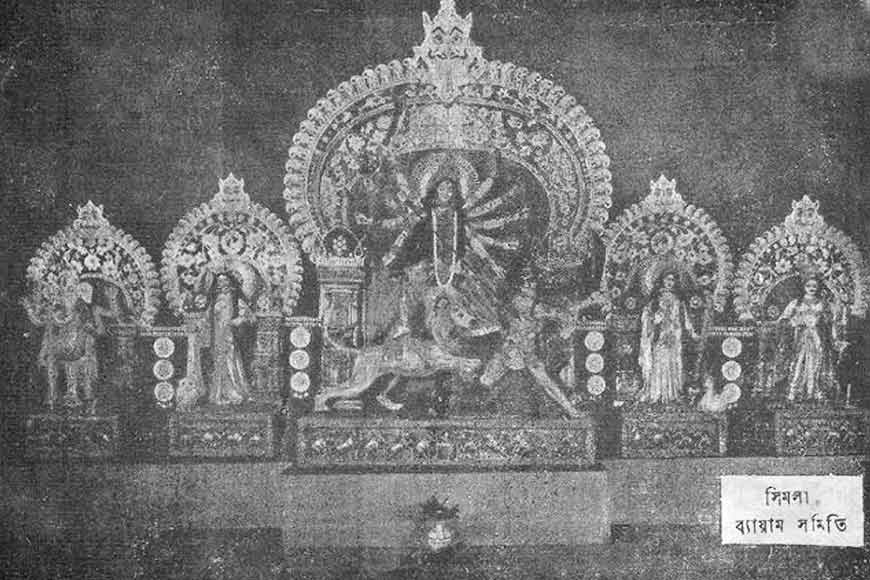Barwari Durga Puja first started in Bengal to uphold Swadeshi sentiments with Netaji at the helm

How about one of the largest festivals of Bengalis being used as a Swadeshi platform against the British. Though Durga Puja is held with great fanfare in Bengal over decades with competitions and various artistic nuances displayed along the streets of Kolkata and districts, before Independence, Durga Puja was used as a symbol of Swadeshi to propagate anti-British sentiments and use the festival as a platform to carry out anti-British protests.
According to historical records, till 1900s, Durga Puja was a major private social event organized by the royalty and wealthy families who utilized the occasion to hob-nob with the British, get close to the ruling class and seek their patronage. As a result, the prominence of Durga puja increased during the British rule in several provinces of Bengal and Assam.
Baghbazar broke the fetters in 1919 when it organised the first Puja in the city that was arranged by the masses communally. It was called ‘baroyari’ (organised by 12 friends) then. It ended the stranglehold of the feudal landlords over the festival. In 1930, when Durgacharan Bandyopadhyay, alder-man of Calcutta Municipal Corporation, became the Puja committee President, he initiated an exhibition as part of the economic movement against the King-Emperor. Only indigenous items were displayed and sold at the venue and people were encouraged to boycott all imported items from Britain.
Pulin Das, an active member of Anushilan Samity, propagated the need to teach every Indian youth techniques of self-defense to take on an oppressive political regime. He initiated the Birashtami Utsav on the morning of Mahastami. Fighting with batons, knives, lances etc. were organized at the venue to inspire the youth. The tradition continues till date but now the weapons have been replaced by a martial arts show.
Netaji Subhas Chandra Bose was directly involved with both Baghbazar Sarbojanin Durgotsav and Simla Bayam Samity Sarbojanin Durga Puja. These two community pujas were facades used for Swadeshi activities and provided shelter to freedom fighters who were forced to go underground during British rule. When Netaji was the Mayor of Calcutta (1930), he donated Rs 500 to the Puja organizers. Later, in 1938-1939, Netaji himself became the president of Baghbazar Sarbojanin Durgotsav committee.
Also read : Why Santhals of Bengal mourn during Durga Puja?
Simla Bayam Samity’s Puja was traditionally held on a plot yards away from Swami Vivekananda’s ancestral house in North Kolkata. The patch of green used to serve as a meeting place for the Anushilan Samity members. On 2nd April, 1926, Atindra Nath Bose, one of the members of the samity founded Simla Bayam Samity with the aim of promoting good health among the youth and inspiring them to join the freedom struggle. He developed the organization into an ideal institute of physical development and a venue for political and social activities. Initially, wrestling and fighting with batons (lathi) were introduced and later military regimental training was initiated. Sporting items including football and volleyball coaching were also launched.
In the inaugural year, the traditional ‘Ek-Chala’ idol of the Goddess was sculpted by Netai Chandra Pal and the temporary roofing of the puja pavilion done with bulrush (‘Hogla pata’) leaves. But the British government was weary of anti-government activities and on 4th January 1932, declared Simla Bayam Samity as illegal and closed it, confiscating all furniture along with sports equipment. The puja, too, could not be organized.
Three years later, in 1939, the ban was finally lifted and the Pujas got a fresh lease of life. This time Vivekananda’s younger brother, Mahendra Nath Dutta took charge. He changed the structure of the idol and set guidelines that have been followed since. Dutta ceaselessly supervised the making of the idols on the compound of the samity and instructed about the structure of the idols, colour, dress, arms placement and so on, everything according to traditional instructions mentioned in the Puranas in Sanskrit verses.
The idol of Goddess Durga was separately installed in a single podium as were all the others. This deviation from ‘Ek Chala’ was unprecedented and the unique installation of the idols created quite a stir in the city. It was very well received by the artists’ circles who heaped praise on this experiment. Many members of the Tagore family visited and appreciated the idol. The idol was unveiled by Netaji. On the occasion of the Puja, a huge ‘Annakaut’ was organized and both Netaji and his sibling, Sarat Chandra Bose and other prominent freedom fighters participated in this ‘Annakaut’ and took ‘prasad’ with the masses.
Initially, the idols of Simla Bayam Samity were dressed in Khadi clothes and people referred to the idols as ‘Swadeshi Thakur.’ As a part of Durgotsav celebration, popular folk art shows and exhibitions were organized to sensitize the masses on socio political issues which included showcasing incidents like the Sepoy Mutiny, Bagha Jatin’s battle at Baleshwar, bravery of Matangini Hazra, Chittagong armory raid, August Revolution, Kohima Struggle, Swami Vivekananda’s call of socialism, death of Mahatma Gandhi, Netaji’s revolutionary life and his mysterious disappearance, necessities of Unity, Rabindranath Tagore and Vivekananda’s ideology through posters.
‘Birastami Puja’ was also an integral part of Durga Puja at Simla Byayam Samity and was attended by bigwigs like Saralabala Devi, Dr. Prafulla Chandra Ray, Amrita Lal Basu and many others.











